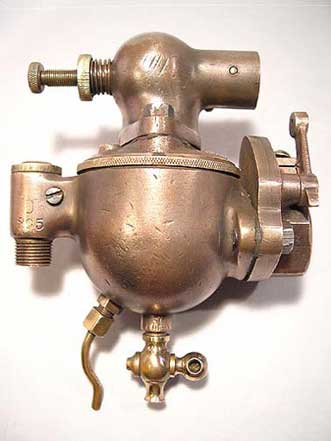|
| Question about carburetor Schebler Mo... |
| Author |
Message |
    
Fr�d�ric Bertrand
Visitor
| | Posted on Wednesday, September 29, 2004 - 10:28 am: | 




|
Hi,
I would like identified this old carburetor Schebler D 205.
Is it only for Marine Engine. Do you know applications data ?
Kindly could you help me ?
Thanks very much for your time.
Sincerely.
Fred.
 |
    
richardday
Senior Member
Username: richardday
Post Number: 309
Registered: 11-2003

| | Posted on Thursday, September 30, 2004 - 08:41 am: | 




|
The model D and its knock off cousins such as Michigan Wheel, Generator Valve Co. Monarch etc. are all so much the same that it is hard to come up with any serious differences as far as applications. The Model D was made up into the 1930s by Schebler and it went on being made by Arcadia, Bridgewater, NS. CA. and Lunenburg Foundry, Lunenburg, CA. up into the 70-80s. It can be used either as an up draft or side draft. It came in 1/2", 3/4", 1", 1-1/4", 1-1/2" and 2" NPT. It came with bolt on check valves or butterfly throttle plates for throttle governed engines such as the Friend sprayer pump engine. It was not a carburetor really designed for automotive operation It was widly used by marine engine makers due to its reliability and simplicity. Most early marine engine application had two speeds. Dead slow and full speed unlike an automobile application. A few are found made from aluminum but most are cast bronze. Prior to about 1930 they were highly polished but during the Great Depression they no longer polished them and most of the NOS units that turn up today have a rough sand cast finish. Either work as well. New synthetic floats can be purchased at [email protected]. The most difficult parts to find are the small cap over the inlet valve and the fuel inlet hex nut with its pipe connection piece. |
    
hugh chalmers
Visitor
| | Posted on Saturday, March 05, 2005 - 06:14 pm: | 




|
Does anyone know the correct procedure for replacing the float?? do you remove the nut on top of the needle valve first then the cross screw and remove the float screw?? I would imagine that it is hard to get the float screw out without destroying the float but since it is going to be new I guess it doesn't matter?? do you need to hold the float pivot while removing the needle valve screw to keep from bending it?? |
    
richardday
Senior Member
Username: richardday
Post Number: 372
Registered: 11-2003

| | Posted on Sunday, March 06, 2005 - 05:13 pm: | 




|
I don't know the official answer. My seat of the pants answer goes like this. Take out the hex nut on top of the float valve first. Don't take out the axle shaft for the float rocker arm until you loosen the float machine screw. Most are 4/36 thread but if you are going to put in one of Paul Grays new synthetic floats don't worry about destroying the cork float. It served its time and its time for a modern float even for us old farts that stick to as little changes as possible a modern float is a welcome addition to the arsenal of antique marine engine nuts. After you get the float loose from the rocker then remove the Axle shaft retaining nut or nuts. These nuts have 1/4"-32thd Some carbs have one on each end of the shaft other only one. If some idiot put in a steel shaft get rid of it and get a piece of bronze brazing rod as a replacement. When you put it all back together just remember Ernies warning regarding the gasket at the the top of the throat just under the top cover. Keep in mind that the apperture of the cap to cover can be anything from a few thou to an 1/8th inch. Neoprene O Rings work great with the larger appertures but you will have have to use cork or gasket material like Paramold I think it is called in the trade. Its a brown paper like gasket material very cheap and very rugged for cutting gaskets. Available from gasket and packing suppliers. Have at it and good luck |
    
hugh chalmers
Visitor
| | Posted on Thursday, March 10, 2005 - 05:22 pm: | 




|
Richard: I was able to change the float much easier than I thought, however, I was fortunate in that none of the screws were frozen. It is 3/4 inch Schebler. The only difficult part was getting the screw back into the new float when in the bowl. I turned the whole thing upside down and screwed it in overhead! Thanks for your encouragement it went faster and easier than I thought. Hugh |
|
|
|


|


